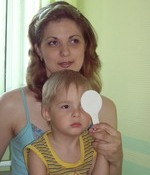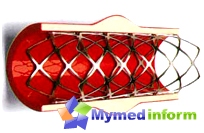Every minute a child with partial or full blindness is born. 20 percent of cases are to blame in trouble - congenital cataract. In the elderly, the operation can be postponed, and with congenital cataract, the time works against the kid. According to experts, congenital cataract must be operated up to 2 years.
Content
 Eye is, in essence, a dark room with one small window - lens. If the window is clean, the light freely comes inside. And if it is opaque, the twilight reigns inside. The degree of mattness can be different. Sometimes it is a small speck on the edge of the lens, which practically does not interfere. But if the cloudy captures all the lens, the vision is reduced significantly. The contours of objects become blurred, and the world is immersed in fog. In rare cases, the crystal is not completely transparent, and then the difference between the light and the shadow is barely catching.
Eye is, in essence, a dark room with one small window - lens. If the window is clean, the light freely comes inside. And if it is opaque, the twilight reigns inside. The degree of mattness can be different. Sometimes it is a small speck on the edge of the lens, which practically does not interfere. But if the cloudy captures all the lens, the vision is reduced significantly. The contours of objects become blurred, and the world is immersed in fog. In rare cases, the crystal is not completely transparent, and then the difference between the light and the shadow is barely catching.
The causes of congenital cataracts are largely a mystery. In some families, blindness is transmitted from generation to generation, but more often a child with a cataract is born in healthy parents. It is known that it is especially dangerous for children's eye infection, transferred by mom during pregnancy: cytomegalovirus infection, herpes, toxoplasmosis.
Some researchers associate congenital cataracts with improper work of parathyroid glands and the mother, and the fetus. Modern ultrasound devices make it possible to detect congenital cataract before the child's birth and prepare for treatment in advance.
Cataract may occur on one eye or struck both. From this dependences and the timing of its treatment. The choice of the method is determined by the degree of turbidity of the lens.
In most cases, congenital cataract does not progress (as opposed to cataracts in those who are unemmed), and as the child grows, the crystal does not purre. Fortunately, she does not go from one eye to another. Nevertheless, doctors insist on treatment from early age. The fact is that for full-fledged eye development should constantly receive visual stimulation. Only then the retina cells will begin to work in full force and become clear paths by which information is transmitted from the eye to the brain.
After birth, any child sees objects fuzzy, lightly blurred. Full-fledged vision is formed only to two years - and then, provided that the eye works tirelessly. When the crystal is muddy, the retina turns out to be in the dark and the cells do not receive due load.
In the elderly, the operation can be postponed: there are already at their retina «trained» Cells. And with congenital cataract, the time works against the baby. If in the first two years the eye will not learn to work, he will never work. That is why it makes no sense to operate congenital cataract after two years. Even if you remove a muddy lens, the light will fall on a dead zone that is unable to perceive visual information.
Today there are no drugs that return transparency crust. How to fix the situation? There are two possibilities: either try to adapt to life with a muddy lens, or remove it.
Numerous studies have established optimal deadlines to carry out such an operation: with full turbidity of the lens on one eye, it is removed from the period after the birth of a child and upon reaching 6 weeks of age; In both eyes - in the interval until three to four months. If the vision is partially saved, that is, the cloudy captured a small part of the lens, the operation may not be needed.
Under the general anesthesia, with the help of miniature surgical instruments, a slight incision is made through which the crystal is removed. In adults, it is destroyed by an ultrasound, but the children crystal is so elastic and fatty, which is easily covered even through a microscopic incision.
Complications after such an operation (bleeding or infection) are extremely rare. The operated child wakes up with a bandage on the eye, which he will have a couple of days. The baby's pain does not feel, so it will very soon feel the tide of the strength and energy that you have to restrain for a whole month - to keep the seams in the integrity and preservation and prevent eye injury. In addition, a few weeks will need to dig drops and regularly show an ophthalmologist.
During surgery, surgeons are removed only. Dense capsule inside which it is located in the eye. Over time, it can be poisoned, and then you will need a re-operation. Fortunately, this happens not often.
Glasses, lenses or prosthesis?
 Crystal performs the most important function: changes its curvature to accurately focus the rays of light on the retina. After removing it, this role takes over the glasses, contact lenses or prosthesis - artificial lens. Each method has its advantages and disadvantages.
Crystal performs the most important function: changes its curvature to accurately focus the rays of light on the retina. After removing it, this role takes over the glasses, contact lenses or prosthesis - artificial lens. Each method has its advantages and disadvantages.
pros. This is the safest method of vision correction. Glasses do not damage and do not irritate their eyes, they are easy to wear and shoot.
Minuses. Try to keep glasses on a one-year-old baby at least five minutes! But for older children is the perfect option. Unfortunately, after removal of cataracts, very thick glasses are needed, which does not like it too and parents, and children.
If only one eye is operated, the glasses are canceled. The brain is not able to normally perceive information if one eye focuses in the usual way, and the other - through the glass.
- Contact lenses
pros. Lenses can be worn on one eye, and on both. Compared to the glasses, they mostly adjust vision and do not spoil appearance.
Minuses. Insert and remove the lenses to a small child (up to five years) - real torment. They fall out when the kid rubs his eyes, then it is losing. If they do not care for them, lenses can be a source of infection.
- Artificial lens
pros. Artificial lens is a small lens made from acrylic or polymethyl methacrylate (PMMA), which is inserted into the eye to the place of unsuitable, muddy crystal. The prosthesis does not require any care, except for regular visits to ophthalmologist. It is not necessary to shoot or change.
Minuses. In case of unforeseen problems, the prosthesis is difficult to remove or replace. Artificial lens is not suitable for quite small children (up to two years), because at this age eyes develop very quickly and change literally in front.
One more «but»: At various age, the need for focusing is different, so from time to time kids with artificial lens are forced to wear glasses or lenses. When the prosthesis is installed, the probability of clouding the lens capsule in the future.
Notice on time - or even earlier
Go to the ophthalmologist as early as possible, even before the child is a month. At the first reception, the doctor dresses the baby drops to expand the pupil and carefully examine the eye bottom. Only so, finding the problem in the earliest stages, you can start treatment in time. In no way, do not postpone the visit to the doctor if:
- The pupil from the baby is not black, and gray or whitish;
- The child constantly rubs his eyes;
- eyelids all the time are inflamed;
- Baby often covers one eye;
- Shakes his head and tilts her forward, then it blinks;
- At the age of two months, the mother does not recognize and does not delay the view on the subjects;
- Baby's eyes all the time «Run» - Without a visible reason, moving from side to side.









